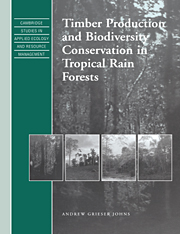Book contents
- Frontmatter
- Contents
- Foreword
- Preface
- Explanatory note
- 1 The issues
- 2 The history and development of tropical forestry
- 3 Changes in the physical environment
- 4 Forest regeneration and gap dynamics
- 5 Responses of individual animal species
- 6 Responses of species assemblages
- 7 Using ecological data in forest management planning
- 8 Intervention to maintain biodiversity
- 9 Field procedures
- 10 The future
- References
- Subject index
3 - Changes in the physical environment
Published online by Cambridge University Press: 04 December 2009
- Frontmatter
- Contents
- Foreword
- Preface
- Explanatory note
- 1 The issues
- 2 The history and development of tropical forestry
- 3 Changes in the physical environment
- 4 Forest regeneration and gap dynamics
- 5 Responses of individual animal species
- 6 Responses of species assemblages
- 7 Using ecological data in forest management planning
- 8 Intervention to maintain biodiversity
- 9 Field procedures
- 10 The future
- References
- Subject index
Summary
Introduction
Logging operations inevitably cause disturbance to the soil surface and to the remaining vegetation, which in turn affects hydrological cycles and can lead to erosion and sedimentation of water systems. This chapter considers how logging operations change the physical environment: the following chapter will consider actual changes to the forest vegetation.
The consequences of logging for the physical environment were first discussed in detail in a widely circulated but unpublished report by Ewel & Conde (1976). This drew attention to the many gaps in knowledge that existed. Amongst other topics, the report stressed the importance of basic research in:
(a) Evaluation of the effects of forest management practices on soil physical, chemical and biological properties, including impacts on soil microorganisms involved in nitrogen cycling, soil structure and tree nutrition (i.e. mycorrhizal fungi).
(b) The relationship between forest management practices and water quality, including chemistry, turbidity and temperature.
(c) The relationship between forest management practices and water yield, including impacts on the total amount, seasonal distribution and rate of return to the initial condition.
(d) Total-system nutrient budgets, including estimates of weathering and rainfall input rates, as well as leaching, runoff and biomass removal loss rates.
Since the 1970s, a considerable amount of research has been focussed on these topics, which together encompass most of the primary physical effects of logging except for the relationship between forest management practices and forest microclimate.
- Type
- Chapter
- Information
- Publisher: Cambridge University PressPrint publication year: 1997



